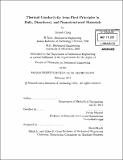Thermal conductivity from first-principles in bulk, disordered, and nanostructured materials
Author(s)
Garg, Jivtesh
DownloadFull printable version (13.04Mb)
Other Contributors
Massachusetts Institute of Technology. Dept. of Mechanical Engineering.
Advisor
Nicola Marzari.
Terms of use
Metadata
Show full item recordAbstract
Thermal conductivity is an important transport property that plays a vital role in applications such as high efficiency thermoelectric devices as well as in thermal management of electronics. We present a first-principles approach based on density-functional perturbation theory (DFPT) to predict the thermal conductivity of semiconducting materials. Heat in these materials is conducted by lattice vibrations (phonons). The most important ingredients in the prediction of thermal conductivity in such materials are the second- and third-order derivatives of energy with respect to atomic displacements. Typically, these are derived using empirical potentials which do not produce the correct harmonic and anharmonic behavior, necessary to accurately compute phonon frequencies and relaxation times. We obtain these derivatives from quantum mechanics through DFPT, and use them along with the solution of the phonon Boltzmann transport equation to predict thermal conductivity. We apply the approach to isotopically pure silicon and germanium as well as materials with disorder such as silicon-germanium alloys and show how this leads to excellent agreement between computed and experimentally measured values. The approach is also applied to predict thermal transport in nanostructured materials such as superlattices. In isotopically pure silicon and germanium, phonons scatter only through the three-phonon anharmonic scattering processes. Using the single-mode relaxation time approximation and estimating the scattering rate of these processes based on the force constants derived from DFPT, excellent agreement is obtained between computed and measured values of thermal conductivity. The approach predicts that in isotopically pure silicon, more than 90% of the heat is conducted by phonons of mean free path larger than 40 nm, providing avenues to lower thermal conductivity through nanostructuring. To predict thermal transport in disordered silicon-germanium alloys of any composition, we make use of the phonon modes of an average crystal which has the two atom unit cell and average mass and force constants appropriate for that composition. The disorder is taken to lead to elastic two-phonon scattering in addition to the three-phonon scattering present in pure materials. The idea was first proposed by Abeles in 1963; however we are able to compute all the ingredients from firstprinciples. The force constants for the composition Sio.5 Geo.5 are obtained by using the virtual crystal where the atomic potential at each site is an average of the silicon and germanium potentials. We demonstrate how this approach can be used to guide design of nanostructured materials to further lower thermal conductivity. In superlattices, we again use the virtual crystal to obtain the second-order and third-force constants. Computed thermal conductivity is found to lower with increase in superlattice period; however, the predicted values are higher than experimentally measured values, and we discuss the cause of this discrepancy. In the limit of very small period superlattice, we find that thermal conductivity can increase dramatically and can exceed that of isotopically pure silicon. This cause of this unexpected result is discussed, and its implications for high thermal conductivity materials, important for applications in thermal management of electronics.
Description
Thesis (Ph. D.)--Massachusetts Institute of Technology, Dept. of Mechanical Engineering, 2011. Cataloged from PDF version of thesis. Includes bibliographical references (p. 133-138).
Date issued
2011Department
Massachusetts Institute of Technology. Department of Mechanical EngineeringPublisher
Massachusetts Institute of Technology
Keywords
Mechanical Engineering.